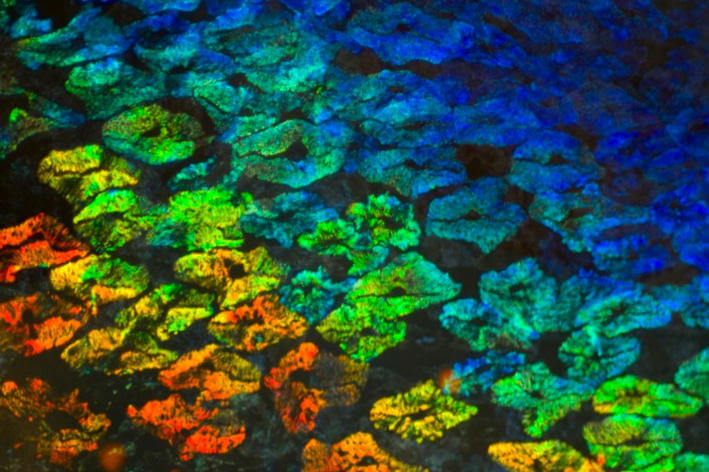Structural colors rely exclusively on the density and shape of the material and not on its chemical properties. The research shows that special cells in the skin of the squid called iridocytes (iridocytes), cells found in some animals that are filled with colorful crystals of guanine

The color of a creature in nature can be created in two ways: pigmentation or presentation of the anatomical structure - colors created from the physical interaction of light with nanobiological components in the body. A wide variety of organisms have this ability, but the biological mechanisms underlying the process were not fully understood.
About two years ago, members of a multidisciplinary team from the University of California at Santa Barbara discovered the mechanism by which a neurotransmitter sharply changes the colors in the common squid in the food markets: Doryteuthis opalescens. This neurotransmitter, known as acetylcholine, creates a series of events that culminates in the addition of phosphorus to a family of proteins known as reflectins. The process allows the protein to become more concentrated, and it drives the process of changing the color of the animal.
This time the researchers went deeper in an attempt to uncover the mechanism responsible for the dramatic color changes used by creatures such as squids and octopuses. The findings were published in the journal PNAS.
Structural colors rely exclusively on the density and shape of the material and not on its chemical properties. The research shows that special cells in the skin of the squid called iridocytes (iridocytes), cells found in some animals are filled with colorful crystals of guanine. These cells contain folds or clefts of the cell membrane that extend deep into the cell. These folds act as an adjustable rag-type reflector. Rag reflectors are named after a British father and son who discovered over a century ago how periodic structures reflect light.
"We know that squid use their glow for camouflage, so they can control their transparency or in some cases adapt to the background," said Daniel Morse, professor of biotechnology in the Department of Cellular and Developmental Molecular Biology and director of the Center for Marine Biotechnology at UCSB, and one of the authors of the paper.
"They also use a mechanism to create confusing patterns to disrupt visual detection by a predator and coordinate interactions between them, especially mating, where they change from one instance to another." he added. "Some species of squid, for example, can change from a bright red color that means "don't come near" to zebra-like stripes that are an invitation to mate."
The researchers created antibodies that bind specifically to the reflectin proteins. It turned out that the reflectin is only found within the layers of these folds in the cell membrane. They showed that the chain of events culminating in the condensation of reflectin causes pressure within the osmotic fold and caused its relationship to water to change drastically. A fold that shrinks and dries causes a reduction in the thickness of the cell and the space between the folds. Water movement was demonstrated directly using deuterium (heavy water).
When the neurotransmitter acetylcholine is washed out and the cell can recover, the folds absorb water allowing them to swell to their original thickness. The change in thickness and spacing in turn create changes in the wavelength of the light, thus "tuning" the color change along the entire visible spectrum.
UCSB researchers are collaborating with military equipment manufacturer Raytheon Vision Systems to explore applications of their discoveries in the development of adjustable filters and shutters to replace infrared cameras. Later this may have possible applications in synthetic camouflage.
For information on the website of the University of California at Santa Barbara
